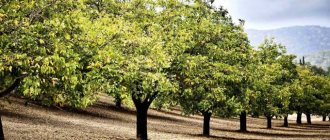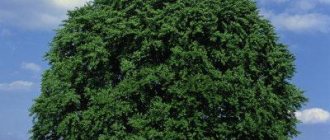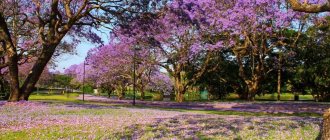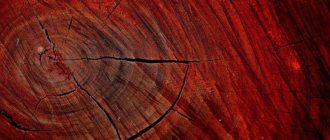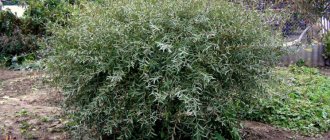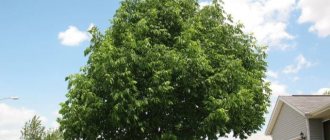Bird cherry belongs to plants of the Plum genus and is related to cherries and plums. Some varieties can live up to 200 years. It grows throughout Russia to the Sea of Okhotsk, including in Eastern and Western Siberia, Asia, Europe, and North Africa. Bird cherry has several popular names: bird cherry, wild garlic and bell. The tree is distinguished by its beautiful and lush flowering, during which it is simply impossible to pass by the bird cherry, the beauty of the tree and its amazing aroma are amazing.
Bird cherry has long symbolized tenderness, purity, youth and love. She is called the patroness of lovers. People believed that bird cherry with its aroma healed mental suffering and protected secrets. There are many legends that tell about the appearance of bird cherry in the world. According to one legend, a girl who suffered from unrequited love turned into a bird cherry. When the tree blooms, cold days and nights come. This happens because the girl’s heart has grown cold.
Bird cherry wood is dense, flexible, but strong and heavy, and is not afraid of moisture. If it dries, it does not crack or warp, it is difficult to split. It is used for carving work with modeling small parts, turning and carpentry work. Previously, bird cherry trees were used to make rollers for washing clothes.
What does it look like
Bird cherry grows in the form of a shrub or tree with a lush and dense crown. The height of the plant is from 10 to 20 meters, the thickness of the trunk can be up to 50 cm. The leaves are green above, dark gray below, and by autumn they become yellowish-red or purple in color. The fruits of the drupe are spherical in shape, with a shiny skin, and come in black, red, dark brown and yellow. The pulp is sweet, sweet and sour, with an astringent taste, there is one seed inside. Bird cherry blossoms with beautiful flowers, collected in clusters of 10-20 pieces. Depending on the variety, the flowers are white, pink or red. The brushes cover the entire tree generously and smell very nice. Wild bird cherry grows mainly along the banks of reservoirs and rivers, in thickets of bushes, forests, on the edges, in forest clearings and on sand.
Pharmacological properties
This is such a wonderful bird cherry. This is a tree or shrub (less often). In any case, its usefulness is undeniable.
Ripe fruits have excellent bactericidal, astringent, vitamin, anti-inflammatory and tonic properties. They bring the functioning of the intestines and stomach back to normal.
The leaves are rich in vitamins and act as a binder for diarrhea. The bark has antipyretic, diaphoretic and diuretic effects.
Flowers are used as a wound-healing, anti-inflammatory and phytoncidal agent.
Varieties
The best varieties of bird cherry:
- Colorata, the branches and bark of the tree are purple in color, the leaves are bright purple, gradually acquiring a dark green hue with purple veins. The flowers are red and acquire a pink tint when blooming. In autumn, the foliage of the tree turns pink-red. Bird cherry fruits are dark red;
- Virginia, the tree grows up to 15 meters in height, the flowers are white, collected in inflorescences, the fruits are dark red. In autumn the leaves turn burgundy-red. The variety has several varieties that differ in the color of the fruit - yellow, black and light red. Trees come with drooping branches and are stunted;
- Antipka, or Magalebskaya, a bush with powerful roots, can live up to 200 years. It is not picky about the soil and does well on rocky slopes. The bark contains coumarin, a substance used in perfumes. It blooms with small white inflorescences that cover the entire bush and emit a pleasant aroma. The fruits are black, small;
- Late, powerful tree with a developed crown, grows up to 20 meters in height. The leaves are bright green in summer, turning yellow-red in autumn. It blooms 2 weeks later than other varieties, at the end of May or beginning of June. The fruits are large and round, black in color, ripen in August. The pulp is juicy, without an astringent aftertaste, with a dessert taste;
- Planaceous, profusely flowering shrub or small tree up to 5 meters high, fruits are dark brown. The pulp is tart and sweet and sour. It ripens early and produces a bountiful harvest, and tolerates winter well;
- Ssyori (Ainu, Far Eastern), a powerful and beautiful tree, grows up to 10-20 meters in height. The blossoming inflorescences are up to 15 cm in length, red-purple in color, gradually acquiring a white tint. The shape of the flowers is bell-shaped, the inflorescences smell very pleasant. The fruits are large, up to 12 mm in diameter;
- Sakhalinskaya, early ripening variety, fruits ripen in July. It tolerates frost well, produces a stable harvest, and is resistant to disease. A tree up to 8 meters high with a powerful crown, large, white flowers. A very similar variety, Self-fertile bird cherry, differs in the taste of the fruit;
- Small-serrated Amagonova, or sakura, this variety is distinguished by the most beautiful flowering. Dome-shaped tree, decorative. The flowers are double, white-pink, cover the entire tree when blooming and emit a delicate aroma.
Bird cherry propagation
To propagate such a plant, cuttings, root shoots and grafting are used. If you wish, you can also grow bird cherry from seeds that are sown in August–September, but it should be noted that trees grown from them very rarely inherit the varietal characteristics of the parent plant.
Propagation by cuttings
It is quite simple and quick to propagate bird cherry by cuttings, which is why this method is the most popular among gardeners. Preparation of cuttings is carried out in the autumn. Young branches are used for cutting, and the length of the cutting can vary from 18 to 20 centimeters. The cuttings need to be saved until spring; to do this, they are wrapped in paper or cloth and put in a cool place. In spring, half a month before planting the cuttings in open soil, they are disinfected using a solution of potassium manganese, and then placed in a glass of water and wait for the roots to grow. When this happens, the cuttings should be planted in moist, loose soil. Caring for cuttings is very simple; to do this, you need to water them in a timely manner and carefully loosen the surface of the soil around them. After the plant has formed a good root system, it should be transplanted to a permanent place. Most gardeners advise rooting the cuttings directly in a permanent place, because transplantation is extremely difficult for them.
Cherry cuttings
Reproduction by taps
To propagate this crop by layering, you need to select a branch on the bush that grows very low. An incision must be made on its bark, and then the branch is bent to the surface of the soil and placed in a trench thirty centimeters deep, which must be prepared a couple of days before the procedure and peat placed in it. Fix the branch in this position and fill the trench with soil, while the top of the cutting should remain on the surface of the soil. In autumn, the cuttings are separated and transplanted to a new location. The advantage of this method of propagation is that the cuttings take root relatively well.
Graft
It is also quite easy to propagate this crop by grafting, especially considering that out of 10 scions, 9.5 take root on the rootstock. Vaccination is carried out in the middle of the summer period. Cuttings taken from young shoots are used as scion.
Benefit
Bird cherry is very useful and valued not only in folk, but also in traditional medicine, due to its rich composition, which includes the following elements:
- gum
- carotene
- Sahara
- essential oil
- anthocyanins
- prunasin, amygdalin
- pectin
- tannins
- gum
- carotene
- vitamin C and P
- boron, cobalt, copper, potassium, zinc, manganese
- organic acids
- routine
- resins
- phenolcarboxylic acids
- flavonoids
- phytoncides
- cyanogenic glycosides
The bark, seeds and flowers contain a glycoside that produces hydrocyanic acid. All parts of the plant are saturated with essential oil with a bitter odor; it contains resins, phytoncides, and gum.
Fruits improve intestinal function, cleanse the body of carcinogens, toxins and waste, and remove salts and heavy metals from tissues. Berries are good for the kidneys and blood vessels, strengthen the walls of capillaries and are a good antioxidant, protect the body from cancer and slow down its aging. A compote made from berries has a beneficial effect on the nervous system and calms, while decoctions from the bark help with high fever, swelling and diarrhea. Leaf tea strengthens the immune system, especially if you add black currant and wild raspberry leaves to it. Bird cherry leaves help relieve pain from injuries and bruises; they are applied to the affected areas of the body. Flowers help with inflammatory processes, as an external remedy for gout and rheumatism.
Useful properties of bird cherry for the body:
- tonic
- restorative
- wound healing
- antimicrobial
- antibacterial
- cleansing
- sweatshop
- antispasmodic
- diuretic
- astringent
Pests and diseases of bird cherry
Bird cherry is susceptible to diseases such as leaf spot (rubella, coniothyriosis, cercospora), powdery mildew, cytosporosis, wood rot, flower and fruit pockets. Among the pests, aphids, herbivorous bugs, leafminer moths, gypsy moths, hawthorn, ermine bird cherry moths and weevils can settle on it.
Cytosporosis
Cytosporosis damages the branches and trunk of the plant, which leads to drying out. In the affected plant, fungal pycnidia (small white tubercles) can be found on the surface of the trunk. On a damp, rainy day, such pycnidia produce threads of a light red color. As soon as the first signs of such a disease are noticed, the infected stems need to be cut out and destroyed, along with the fallen leaves and fruits. In the spring, before the foliage opens, it is necessary to treat the bird cherry with Bordeaux mixture (1%) or copper oxychloride. In March, large branches and trunk should be washed with iron sulfate. In autumn, the surface of the trunk must be whitened using lime.
Wood rot
Wood rot begins to develop due to the tinder fungus. The plant becomes infected through wounds on the bird cherry bark. As wood rots, there is a change in its physical and chemical properties, as well as structure. If you promptly detect the point of penetration of the fungus and strip it down to healthy wood, and also cover it with clay mixed with fungicide, this can save the plant. If the disease is advanced, then the bird cherry can no longer be saved.
Pockets of flowers and fruits
The most dangerous fungal disease that bird cherry can get is the pockets of flowers and fruits. During the development of the disease, deformation of the fruits is observed, seeds do not grow in them, and a coating appears on their surface, which consists of bags of the causative fungus. Infected flowers most often die, while the ovary does not form, and oppression of the entire tree is also observed. Pick off all affected fruits or flowers. Before the tree blooms, it should be sprayed with a solution of copper sulfate (1%), iron sulfate (3%) or Bordeaux mixture (1%).
Powdery mildew
If a cobwebby white coating appears on the stems and foliage, it means that the specimen is infected with powdery mildew. After some time, this plaque becomes less noticeable, but dark-colored fungal fruiting bodies appear on it, which are clearly visible. In spring, a resumption of the disease is observed.
Polystigmosis
Polystigmosis, either rubella or red leaf spot, is a fungal disease. In the affected specimen, deep red spots form on the surface of the foliage, which are clearly visible against a green background. The infected plant and the surface of the trunk circle, before the buds open, must be sprayed with a solution of Nitrafen or copper sulfate, and its concentration should be 3%. When the plant fades, it is treated with Bordeaux mixture (1%). If the bird cherry is very badly affected, then you should spray it with a fungicidal preparation for the third time 15–20 days after it has finished flowering.
Cercospora
If small necroses of irregular shape appear on the surface of the leaf blades, this means that the tree is affected by cercospora. On the front surface of the leaf plate they are whitish in color, and on the back they are brown. Over time, they merge, and destruction and rash of the affected tissue is observed. To get rid of such a disease, the tree must be treated with Topaz, which must be used in accordance with the instructions.
Koniotiriosis
Koniotiriosis damages the bark of branches, foliage and fruits. On the affected parts of the plant, the appearance of merging or single necrosis of an irregularly rounded shape of brown or yellow color, with a dark orange border, is observed. Black pycnidal dots appear in the central part of these necroses. To cure bird cherry, it must be treated with a fungicide.
During the season, 2 preventive treatments are carried out against harmful insects: at the beginning of spring, before the foliage opens, and also at the end of flowering. Spray the plant with a solution of Karbofos (60 grams per 1 bucket of water), and about 2 liters of this product should be consumed per specimen.
Pests on bird cherry
Application in medicine
Preparations, infusions and decoctions prepared from the fruits, leaves, bark and flowers of bird cherry are used to treat various health problems:
- gastrointestinal diseases
- diarrhea
- headaches and migraines
- inflammatory processes
- festering and infected wounds
- angina
- laryngitis
- stomatitis and caries
- diseases of the female genitourinary system
- purulent conjunctivitis
- radiculitis
- rheumatism
- arthritis and arthrosis
- colds
- intestinal infections
- nephritis
- bronchitis
- tuberculosis
- kidney diseases
- diseases of the cardiovascular system
- hypertension
- dysentery
- fever
- Koch's wand
- acne, scabies, psoriasis
- venereal diseases
- colpitis
Recipes for healing drinks
Bark decoction
- Pour 1 teaspoon of bark powder into a glass of boiling water;
- simmer over low heat for 15 minutes and cool;
- strain the drink and add boiled water to get the original volume of liquid;
- take 150-170 ml daily, 3 times a day.
Fruit decoction
- Grind a tablespoon of fresh or dried berries in a wooden mortar;
- pour 200 ml of boiling water over the fruits and simmer for 15 minutes in a water bath;
- leave the drink to brew for 40 minutes, strain;
- If you have digestive problems, take 100 ml, 2 times a day.
Recipes
Bird cherry compote
Ingredients:
- 1 kg of berries;
- 1.3 liters of water;
- 300 g sugar.
Preparation:
- Rinse the bird cherry in warm water and blanch for 2 minutes.
- Prepare syrup from sugar and water.
- Pour the fruits into an enamel pan, pour hot syrup and leave for 5 hours. There is no need to cover the dish with a lid.
- Remove the berries and place in sterilized jars, filling each one ¼ full.
- Pour in the boiling syrup and roll up the compote.
An ancient recipe for bird cherry liqueur
Preparation:
- Wash the fruits, scatter them on a cloth and leave for 3 days.
- Place the bird cherry on a board or sieve and place in a preheated stove or oven.
- When the berries are wrinkled, but not yet completely dry, crush them and pour them into a bottle, filling it to the neck.
- Pour vodka over the bird cherry and leave for 6 weeks.
- Pour the liqueur into another container and add sugar, stir. Store in the cellar.
Landing rules
When planting, you should take into account some botanical features of this ornamental berry crop:
- the plant is undemanding to the composition of the soil on the site and is perfect for growing on light sandy, as well as medium loamy and heavy clay soils;
- It is allowed to grow bird cherry on acidic, neutral and alkaline soils;
- it is preferable to grow the crop in moist, rich, well-drained soils with a fairly close groundwater table;
- bird cherry, especially young ones, is shade-tolerant, so the plant can be placed in shade and partial shade;
- To achieve high yields, bird cherry must be grown in well-lit areas.
It is important to remember that good lighting is very important for decorative forms of bird cherry; With significant shading, plants can quickly lose their decorative effect.
Storage
The berries can be canned and ground with sugar. The fruits are frozen and dried, ground into flour, which is widely used in cooking and cosmetology. The flowers, bark and leaves are dried and then brewed as a decoction or tea. The shelf life of dried flowers is 1 year, the bark is suitable for consumption for 5 years.
It is better to make jam without seeds, so its shelf life will be longer. If the delicacy is cooked with a bone, it can only be eaten for 1 year.
Drying bird cherry
- wash the berries, separate them from the branches and dry them;
- Place on a baking sheet in an even layer and place in an oven preheated to 50 degrees;
- Stir the fruits from time to time during the drying process. Well-dried bird cherry has a wrinkled surface and dark color;
- Sort the finished fruits, remove the burnt ones and place them again on the baking sheet. Leave it to dry a little longer on the balcony or in the shed;
- store berries in boxes or fabric bags in a well-ventilated and dry place. The shelf life of this product is 5 years.

